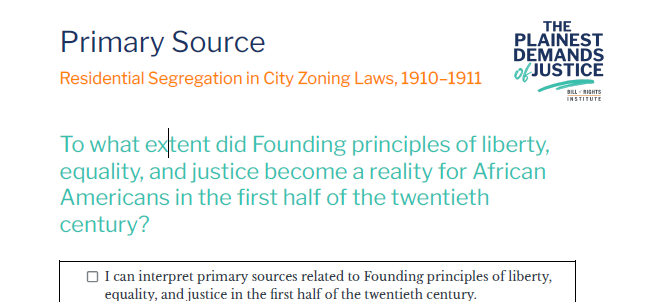Residential Segregation in City Zoning Laws, 1910-1911
Get The Scaffolded Version
Guiding Question: To what extent did Founding principles of liberty, equality, and justice become a reality for African Americans from Reconstruction to the end of the nineteenth century?
- I can interpret primary sources related to Founding principles of liberty, equality, and justice from the colonial era to the outbreak of the Civil War.
- I can explain how laws and policy, courts, and individuals and groups contributed to or pushed back against the quest to end slavery.
- I can create an argument using evidence from primary sources.
- I can analyze issues in history to help find solutions to present-day challenges.
Building Context
As more Black Americans poured into northern cities in the Great Migration, cities began codifying segregation. The first racial zoning ordinance was proposed by Baltimore’s Mayor J. Barry. Other cities in the north and south alike adopted ordinances similar to those listed below. In 1917, the Supreme Court struck down these ordinances in Buchanan v. Warley, ruling that such zoning laws interfered with the right of a property owner to sell to whomever they pleased.
Residential Segregation in City Zoning Laws, 1910-1911
Source Link: https://archive.org/details/jstor-1105494/page/n3/mode/2up (pg. 4)
Baltimore, Maryland Zoning Ordinance, 1910
An ordinance for preserving peace, preventing conflict and ill feeling between the white and colored races in Baltimore city, and promoting the general welfare of the city by providing, so far as practicable, for the use of separate blocks by white and colored people for residences, churches and schools.
Richmond, Virginia Zoning Ordinance, 1911
Be it ordained by the council of the city of Richmond:
1. That it shall be unlawful for any white person to occupy a residence or to establish and maintain as a place of public assembly, any house upon any street or alley between two adjacent streets on which a greater number of houses are occupied as residences by colored people than are occupied as residences by white people.
2. That it shall be unlawful for any colored person to occupy a residence or to establish and maintain as a place of public assembly, any house upon any street or alley between two adjacent streets on which a greater number of houses are occupied as residences by white people than are occupied as residences by colored people. . . .
5. Every person either by himself or through his agent violating . . . any one or more of the provisions of this ordinance shall be liable to a fine of not less than one hundred nor more than two hundred dollars . . . and, in the discretion of the police justice of the city of Richmond, such person may, in addition therefore, be confined in the city jail not less than thirty nor more than ninety days.
Comprehension and Analysis Questions
- According to the Baltimore ordinance, what was the purpose of segregating Black Americans from whites?
- How was the Richmond ordinance to be enforced?
